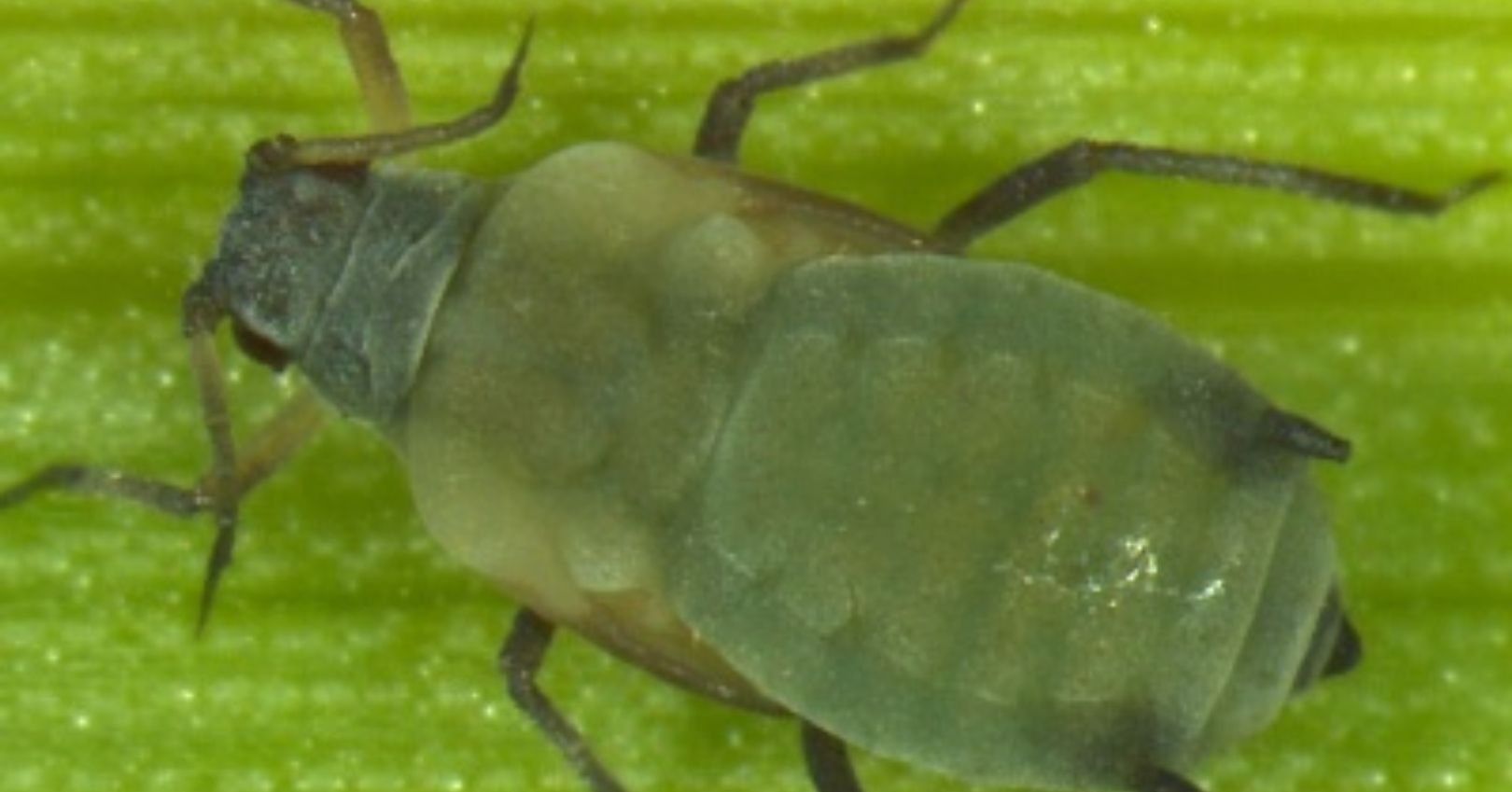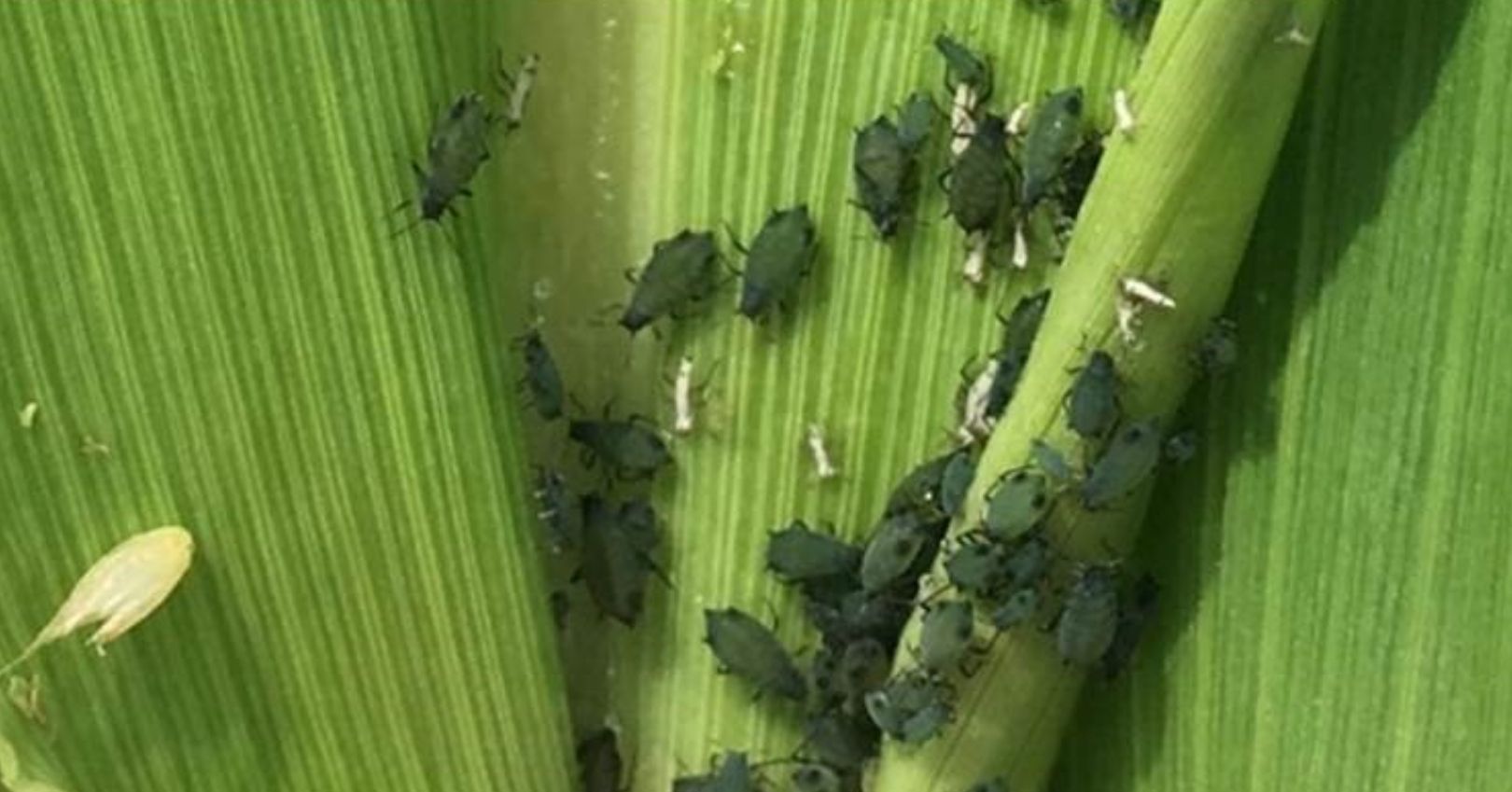Corn Leaf Aphid


Description
Adult: Oval, wingless, 0.08 inch (2.0 mm) long; pale bluish-green body with black antennae, legs, and cornicles (pair of tubes on posterior back). Winged form: similar in size to the wingless adult but has fragile transparent wings held roof-like over the body.
Egg: None. Females give birth to live young.
Nymph: Similar in appearance to the wingless adult, but smaller.
Note: While other aphids such as the greenbug (Schizaphis graminum) and the bird cherry-oat aphid (Rhopalosiphum padi) may be present, the corn leaf aphid (CLA) is the most important aphid pest on corn in Utah. The greenbug aphid adult is pear shaped and has a light green abdomen with a darker stripe down the middle. This aphid species is primarily a pest in small grains and sorghum. The bird cherry-oat aphid adult is pear-shaped and ranges in color from yellowgreen to olive green or black. Their cornicles and antennae are dark and often have a rusty colored patch around the cornicles. Bird cherry-oat aphids prefer wheat, barley, oats, rye, and triticale, and are less common on corn.
Life History
Corn leaf aphids (CLA) overwinter as adults in warmer and more southern locations. They fly or are carried north on wind currents in the spring, and show up in northern Utah in June and early July. Winged aphids fly in search of suitable hosts which include barley, sorghum, corn and other grasses, including weeds. Females give birth to live nymphs which typically develop into wingless adult females. Males are rare. Development of nymphs into adults requires 7 to 14 days. As the nymphs grow, tiny white, flakey cast skins are shed, which can give the appearance of white mold or ash. Winged females may develop when feeding conditions are unfavorable and the colony becomes crowded. Winged females disperse to establish new colonies while the wingless females remain in the parent colony or walk short distances to also establish new colonies. There are about nine generations per season.
Damage
CLA populations begin in corn about 4 weeks prior to tasseling and then will quickly decline after tassel emergence. Damage is most severe between the latewhorl and pollination stages. Aphids feed by sucking sap from young leaves in the whorl of the plant, and then move to the upper leaves and tassels. Aphid feeding on leaves causes mottling and discoloration and can make leaves turn red or yellow when feeding is severe (Fig. 10.11). Infested tassels become covered in a sticky substance excreted by the feeding aphids, known as honeydew, possibly interfering with pollination and causing poor kernel fill. Infested plants may take on a black or sooty appearance due to a fungus that feeds and thrives on the honeydew. Heavily infested tassels may wilt and turn brown. All three aphid species mentioned (CLA, greenbug, and bird cherry-oat) transmit maize dwarf mosaic virus to corn from nearby sources.
Management
Cultural
- Plant early. CLA tend to be a problem in the fall on late-planted corn.
- Ensure adequate irrigation. Drought-stressed plants are more susceptible to aphid feeding injury.
- Use scouting/monitoring techniques. Scout for aphids before tasseling (ideally 3 weeks before). Choose five locations within a field and check at least 10 plants at each location. Use a hand lens to carefully examine the ear, leaves, and stalk of plants. Carefully pull the whorl of leaves away from the stalk and unroll them, examining leaves for aphids. Estimate the number of aphids per plant excluding any that appear off-colored since these aphids may be diseased or parasitized.
- Use reflective mulches. Metallic and red mulches can reduce early-season aphid populations.
- Control weeds. Good weed control can eliminate or reduce alternate virus and food sources for aphids.
- Inspect transplants before field-planting. Prevent introducing new populations to a site.
- Remove weeds. Reduce the amount of umbelliferous weeds in and near the growing site as they serve as alternative hosts.
- Avoid excessive fertilization. Aphid densities tend to be higher on vigorously growing plants that have received excess nitrogen.
- Foliage pruning. If the population is identified on a few leaves, they can be pruned out.
- Treat nearby woody hosts with horticultural oil at bud burst.
Chemical
Aphid infestations typically can be controlled by biological and environmental factors, but if 50% or more of the plants checked have more than 100 aphids per plant, the tassels are coated in honeydew, and plants are under drought stress, chemical treatment may be necessary.
Biological
Natural enemies of aphids include predators such as lacewings, lady beetles, and syrphid or hover flies. The parasitic wasp Lysiphlebus testaceipes specializes in attacking aphids. It lays an egg inside the aphid where its larva feeds on internal tissues, killing the aphid. The newly developed adult wasp cuts a hole in the aphid back and emerges. The dead brown body of the aphid is called an “aphid mummy.”
Note: Predators and parasites usually don’t reduce aphid populations quickly enough to prevent virus infection.

